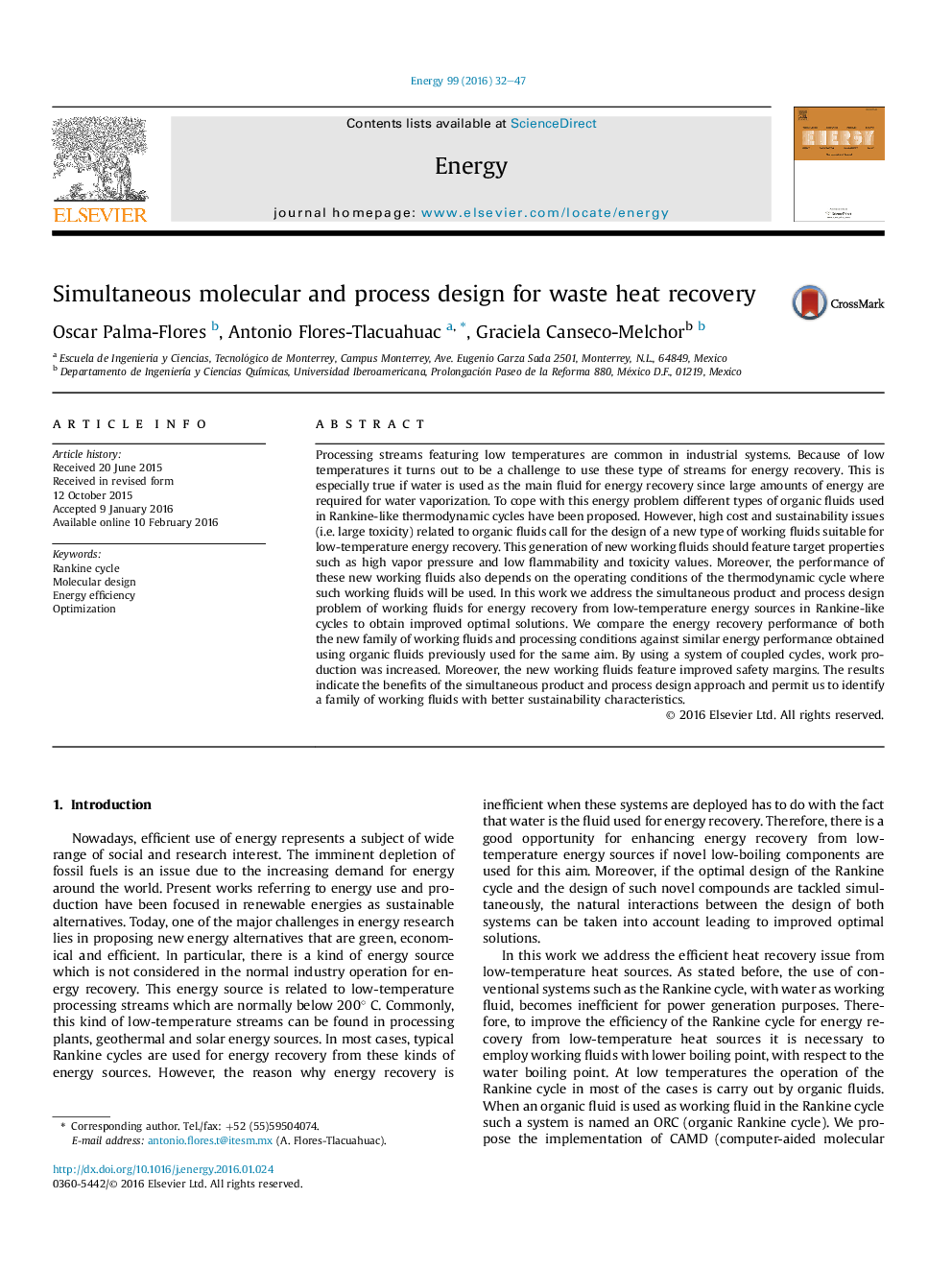| کد مقاله | کد نشریه | سال انتشار | مقاله انگلیسی | نسخه تمام متن |
|---|---|---|---|---|
| 1731314 | 1521449 | 2016 | 16 صفحه PDF | دانلود رایگان |
عنوان انگلیسی مقاله ISI
Simultaneous molecular and process design for waste heat recovery
ترجمه فارسی عنوان
طراحی همزمان مولکولی و فرآیند برای بازیابی حرارت ضایعات
دانلود مقاله + سفارش ترجمه
دانلود مقاله ISI انگلیسی
رایگان برای ایرانیان
کلمات کلیدی
چرخه راکتین، طراحی مولکولی، بهره وری انرژی، بهینه سازی،
ترجمه چکیده
جریان های پردازش با دمای پایین در سیستم های صنعتی رایج هستند. از آنجا که درجه حرارت پایین است، تبدیل به یک چالش برای استفاده از این نوع جریان برای بازیابی انرژی می شود. این به خصوص اگر آب به عنوان مایع اصلی برای بازیافت انرژی استفاده شود، زیرا مقدار زیادی از انرژی برای تبخیر آب لازم است. برای مقابله با این مشکل انرژی انواع مختلفی از مایعات آلی که در چرخه ترمودینامیکی مانند رنکین استفاده می شوند پیشنهاد شده است. با این حال، مسائل مربوط به هزینه های بالا و پایداری (یعنی سمیت شدید) مربوط به مایعات ارگانیک، طراحی یک نوع جدید از مایعات کاری مناسب برای بازیافت انرژی با دمای پایین است. این نسل از مایعات کار جدید باید دارای خواص هدف مانند فشار بخار بالا و کم اشتعال و مقادیر مسمومیت باشد. علاوه بر این، عملکرد این مایعات کار جدید نیز بستگی به شرایط عملیاتی چرخه ترمودینامیکی که در آن چنین مایعات کار می شود مورد استفاده قرار می گیرد. در این کار ما به مسئله تولید همزمان و فرآیند طراحی مایعات کارکرد برای بازیافت انرژی از منابع انرژی کم دمای در چرخه های رنکین می پردازیم تا راه حل های بهینه را به دست آوریم. ما عملکرد بازیابی انرژی هر دو خانواده جدید از مایعات کار و شرایط پردازش را نسبت به عملکرد مشابه انرژی که با استفاده از مایعات ارگانی که قبلا برای همین هدف استفاده شده است مقایسه می کنیم. با استفاده از یک سیستم چرخه های همراه، تولید کار افزایش یافت. علاوه بر این، مایعات کار جدید دارای حاشیه ایمنی بهتر است. نتایج نشان می دهد که مزایای رویکرد طراحی محصول و فرآیند همزمان و اجازه می دهد ما را به شناسایی خانواده از مایعات کار با ویژگی های پایداری بهتر.
موضوعات مرتبط
مهندسی و علوم پایه
مهندسی انرژی
انرژی (عمومی)
چکیده انگلیسی
Processing streams featuring low temperatures are common in industrial systems. Because of low temperatures it turns out to be a challenge to use these type of streams for energy recovery. This is especially true if water is used as the main fluid for energy recovery since large amounts of energy are required for water vaporization. To cope with this energy problem different types of organic fluids used in Rankine-like thermodynamic cycles have been proposed. However, high cost and sustainability issues (i.e. large toxicity) related to organic fluids call for the design of a new type of working fluids suitable for low-temperature energy recovery. This generation of new working fluids should feature target properties such as high vapor pressure and low flammability and toxicity values. Moreover, the performance of these new working fluids also depends on the operating conditions of the thermodynamic cycle where such working fluids will be used. In this work we address the simultaneous product and process design problem of working fluids for energy recovery from low-temperature energy sources in Rankine-like cycles to obtain improved optimal solutions. We compare the energy recovery performance of both the new family of working fluids and processing conditions against similar energy performance obtained using organic fluids previously used for the same aim. By using a system of coupled cycles, work production was increased. Moreover, the new working fluids feature improved safety margins. The results indicate the benefits of the simultaneous product and process design approach and permit us to identify a family of working fluids with better sustainability characteristics.
ناشر
Database: Elsevier - ScienceDirect (ساینس دایرکت)
Journal: Energy - Volume 99, 15 March 2016, Pages 32-47
Journal: Energy - Volume 99, 15 March 2016, Pages 32-47
نویسندگان
Oscar Palma-Flores, Antonio Flores-Tlacuahuac, Graciela Canseco-Melchorb,
